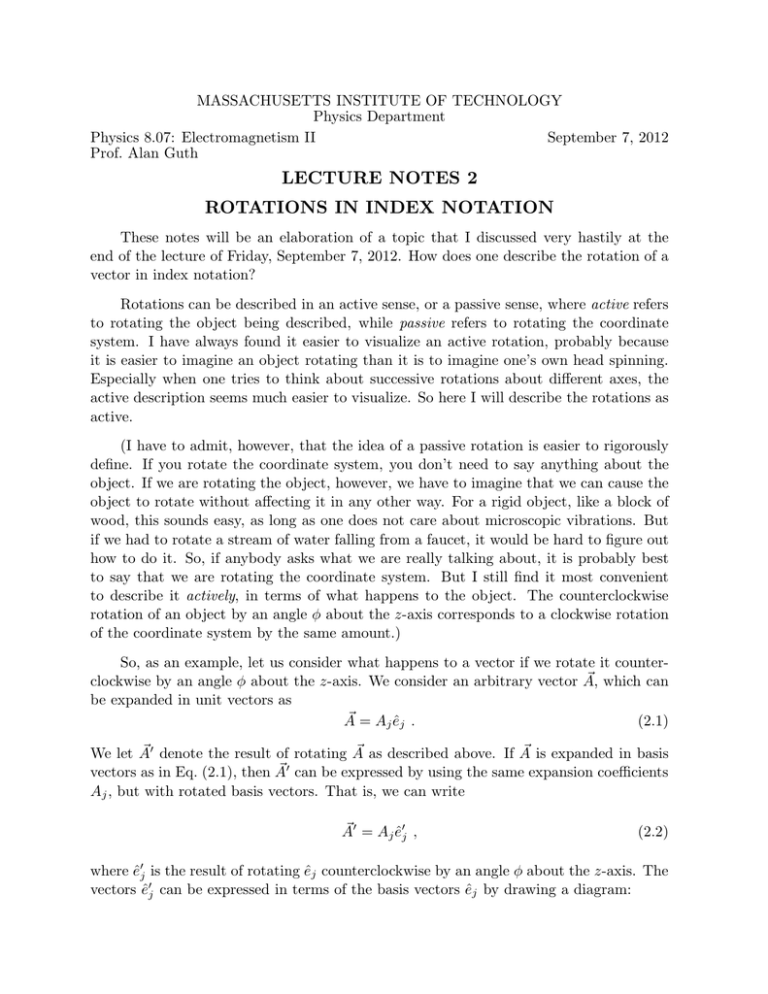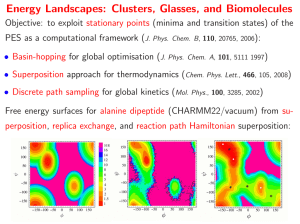Document 13614604
advertisement

MASSACHUSETTS INSTITUTE OF TECHNOLOGY Physics Department Physics 8.07: Electromagnetism II September 7, 2012 Prof. Alan Guth LECTURE NOTES 2 ROTATIONS IN INDEX NOTATION These notes will be an elaboration of a topic that I discussed very hastily at the end of the lecture of Friday, September 7, 2012. How does one describe the rotation of a vector in index notation? Rotations can be described in an active sense, or a passive sense, where active refers to rotating the object being described, while passive refers to rotating the coordinate system. I have always found it easier to visualize an active rotation, probably because it is easier to imagine an object rotating than it is to imagine one’s own head spinning. Especially when one tries to think about successive rotations about different axes, the active description seems much easier to visualize. So here I will describe the rotations as active. (I have to admit, however, that the idea of a passive rotation is easier to rigorously define. If you rotate the coordinate system, you don’t need to say anything about the object. If we are rotating the object, however, we have to imagine that we can cause the object to rotate without affecting it in any other way. For a rigid object, like a block of wood, this sounds easy, as long as one does not care about microscopic vibrations. But if we had to rotate a stream of water falling from a faucet, it would be hard to figure out how to do it. So, if anybody asks what we are really talking about, it is probably best to say that we are rotating the coordinate system. But I still find it most convenient to describe it actively, in terms of what happens to the object. The counterclockwise rotation of an object by an angle φ about the z-axis corresponds to a clockwise rotation of the coordinate system by the same amount.) So, as an example, let us consider what happens to a vector if we rotate it counter­ A which can clockwise by an angle φ about the z-axis. We consider an arbitrary vector A, be expanded in unit vectors as A = Aj êj . (2.1) A A j denote the result of rotating A A as described above. If A A is expanded in basis We let A j A can be expressed by using the same expansion coefficients vectors as in Eq. (2.1), then A Aj , but with rotated basis vectors. That is, we can write A j = Aj êj , A j (2.2) where êjj is the result of rotating êj counterclockwise by an angle φ about the z-axis. The vectors êjj can be expressed in terms of the basis vectors êj by drawing a diagram: 8.07 LECTURE NOTES 2, FALL 2012 p. 2 One can read from the diagram that êjx = êx cos φ + êy sin φ êjy = −êx sin φ + êy cos φ (2.3) êjz = eˆz . We can rewrite the above equation by defining a matrix Rij , writing êjj = êi Rij , (2.4) where in this case we call the rotation matrix Rz (φ), with j=1 Rz (φ)ij i=1 cos φ sin φ = i=2 i=3 0 j=2 j=3 − sin φ cos φ 0 0 0 1 . (2.5) When Rij is written as a matrix, the first index (in this case i) labels the rows, and the second index (j in this case) labels the columns. By substituting Eq. (2.4) into Eq. (2.2), we find A j = Aj êi Rij , A or, by reordering the factors, A j = (Rij Aj ) êi . A (2.6) A j are defined by The components Aji of the vector A A j = Aj êi , A i (2.7) so by comparing Eq. (2.6) with Eq. (2.7), we see that Aji = Rij Aj , (2.8) 8.07 LECTURE NOTES 2, FALL 2012 p. 3 where of course j is summed from 1 to 3, since it is a repeated index. Note that if the repeated indices are adjacent, as in Eq. (2.8), and if the number of indices on any one factor is not larger than two, then the index notation is just another way of writing matrix multiplication. That is, Eq. (2.8) could also be written as an explicit matrix equation, j A1 R11 Aj = R 2j 21 R31 A3 R12 R22 R32 R13 A1 , A R23 2 R33 A3 (2.9) where the rules for matrix multiplication are equivalent to the sum over j. As an aside,* I mention that it is not difficult to generalize Eq. (2.5) to describe a rotation about the direction of n̂, where n̂ is an arbitrary unit vector. Eq. (2.5) describes rotations for n̂i = δi3 , so we can try to rewrite Eq. (2.5) in terms of n̂. If we start with the matrix elements on the diagonal, we can get those right by writing Rz (φ)ij = δij cos φ + n̂i n̂j (1 − cos φ) + off-diagonal terms. The off-diagonal elements are not so obvious. We want R21 = −R12 = sin φ, while the other off-diagonal terms should vanish. With a little thought, we see that we can build such an expression out of n̂ and the Levi-Civita symbol: R(n̂, φ)ij = δij cos φ + n̂i n̂j (1 − cos φ) − εijk n̂k sin φ . (2.10) By inspection, we can see that Eq. (2.10) agrees with Eq. (2.5) for the special case n̂ = êz . But any other case is just a rotation of this case. If we knew just a little more about rotational invariance than we are going to include in this course, we would be able to conclude that both sides of Eq. (2.10) behave the same way under rotations; that is, they behave as tensors. Thus, if the equation is valid for the coordinate system in which the rotation axis is the z-axis, then it is also valid in any rotated system, where n̂ is an arbitrary unit vector. * An “aside” means that if you have trouble following this part, you can safely ignore it. It will not be needed for the rest of the course, and will not appear on any exams. MIT OpenCourseWare http://ocw.mit.edu 8.07 Electromagnetism II )DOO For information about citing these materials or our Terms of Use, visit: http://ocw.mit.edu/terms.
![MA1S12 (Timoney) Tutorial sheet 5b [February 17–21, 2014] Name: Solutions](http://s2.studylib.net/store/data/011008024_1-aff7ce804bc4e58f7a43f1b077bfbe2a-300x300.png)
![MA1S12 (Timoney) Tutorial sheet 5a [February 17–21, 2014] Name: Solutions](http://s2.studylib.net/store/data/011008023_1-3d92d2b687d65c81aed78c29a4362506-300x300.png)



